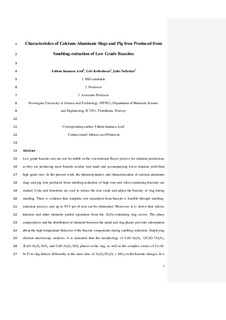Characteristics of Calcium-Aluminate Slags and Pig Iron Produced from Smelting-Reduction of Low-Grade Bauxites
Journal article, Peer reviewed
Accepted version

Åpne
Permanent lenke
http://hdl.handle.net/11250/2594118Utgivelsesdato
2018Metadata
Vis full innførselSamlinger
- Institutt for materialteknologi [2540]
- Publikasjoner fra CRIStin - NTNU [37737]
Originalversjon
Metallurgical and materials transactions. B, process metallurgy and materials processing science. 2018, 49 (5), 2400-2420. 10.1007/s11663-018-1353-1Sammendrag
Low-grade bauxite ores are not favorable in the conventional Bayer process for alumina production, as they are producing more bauxite residue (red mud) and accompanying lower alumina yield than high-grade ores. In the current study, the thermodynamics and characterization of calcium-aluminate slags and pig iron produced from smelting reduction of high iron- and silica-containing bauxites are studied. Coke and limestone are used to reduce the iron oxide and adjust the basicity of slag during smelting. There is evidence that complete iron separation from bauxite is feasible through smelting-reduction process, and up to 99.9 pct of iron can be eliminated. Moreover, it is shown that the partial separation of silicon, titanium, and other elements from the Al2O3-containing slag occurs. The phase compositions and the distribution of elements between the metal and slag phases provide information about the high-temperature behavior of the bauxite components during smelting reduction. Employing electron microscopy analysis, it is indicated that the morphologies of CaO.Al2O3, 12CaO.7Al2O3, 2CaO.Al2O3.SiO2, and CaO.Al2O3.SiO2 phases in the slag, as well as the complex oxides of Ca-Al-Si-Ti in the slag behave differently as the mass ratio of Al2O3/(Fe2O3+SiO2) in the bauxite changes. It is also shown that the phases of slag produced from smelting-reduction below 5 K/s of cooling rate are proper for further leaching process. Characteristics of Calcium-Aluminate Slags and Pig Iron Produced from Smelting-Reduction of Low-Grade Bauxites
